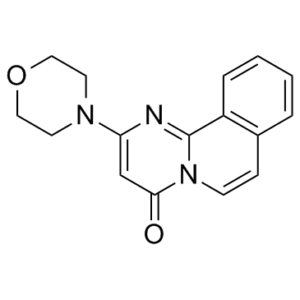COMPOUND 401
This product is for research use only, not for human use. We do not sell to patients.

For small sizes, please check our retail website as below: www.invivochem.com
| Size | Price | Stock |
|---|---|---|
| 250mg | $650 | Check With Us |
| 500mg | $1110 | Check With Us |
| 5g | $1665 | Check With Us |
Cat #: V3996 CAS #: 168425-64-7 Purity ≥ 98%
Description: Compound 401 is a potent synthetic inhibitor of DNA-dependent protein kinase (DNA-PK, IC50 = 0.28 μM) that also targets mTOR but not PI3K in vitro.
Top Publications Citing Invivochem Products
Publications Citing InvivoChem Products
Product Promise

- Physicochemical and Storage Information
- Protocol
- Related Biological Data
- Stock Solution Preparation
- Quality Control Documentation
| Molecular Weight (MW) | 281.32 |
|---|---|
| Molecular Formula | C16H15N3O2 |
| CAS No. | 168425-64-7 |
| Storage | -20℃ for 3 years in powder formr |
| -80℃ for 2 years in solvent | |
| Solubility In Vitro | DMSO: ≥ 5 mg/mLr |
| Water: N/Ar | |
| Ethanol: N/A | |
| SMILES Code | O=C1C=C(N2CCOCC2)N=C3N1C=CC4=C3C=CC=C4 |
| Synonyms | Compound 401; Compound401; Compound-401 |
| Protocol | In Vitro | Compound 401 is a potent inhibitor of DNA-PK (IC50=0.28 μM). Compound 401 is reported to be a poor inhibitor of PI3K, ATM, and ATR in vitro, but it is active against mTOR. Compound 401 shows activity against mTOR (IC50=5.3 μM) but not p110α/p85α PI3K (IC50>100 μM). Treatment of cells with Compound 401 blocks the phosphorylation of sites modified by mTOR-Raptor and mTOR-Rictor complexes (ribosomal protein S6 kinase 1 Thr389 and Akt Ser473, respectively). By contrast, there is no direct inhibition of Akt Thr308 phosphorylation, which is dependent on PI3K. Similar effects are also observed in cells that lack DNA-PK. Compound 401 inhibits immunoprecipitated epitope-tagged mTOR or endogenous mTOR in Raptor immunoprecipitates. In both cases, inhibition of 67% or 78% is obtained at 5 μM or 10 μM Compound 401, respectively. By contrast, dose response curves show that the p110α/p85α or p110β/p85α PI3K complexes are poorly inhibited by Compound 401 at these concentrations. The proliferation of TSC1-/- fibroblasts is inhibited in the presence of Compound 401, but TSC1+/+ cells are resistant. |
|---|
These protocols are for reference only. InvivoChem does not
independently validate these methods.
| Solvent volume to be added | Mass (the weight of a compound) | |||
|---|---|---|---|---|
| Mother liquor concentration | 1mg | 5mg | 10mg | 20mg |
| 1mM | 3.5547 mL | 17.7734 mL | 35.5467 mL | 71.0934 mL |
| 5mM | 0.7109 mL | 3.5547 mL | 7.1093 mL | 14.2187 mL |
| 10mM | 0.3555 mL | 1.7773 mL | 3.5547 mL | 7.1093 mL |
| 20mM | 0.1777 mL | 0.8887 mL | 1.7773 mL | 3.5547 mL |
The molarity calculator equation
Mass(g) = Concentration(mol/L) × Volume(L) × Molecular Weight(g/mol)
Mass
=
Concentration
×
Volume
×
Molecular Weight*
The dilution calculator equation
Concentration(start)
×
Volume(start)
=
Concentration(final)
×
Volume(final)
This equation is commonly abbreviated as: C1 V1 = C2 V2
Concentration(start)
C1
×
Volume(start)
V1
=
Concentration(final)
C2
×
Volume(final)
V2
Step One: Enter information below
Dosage mg/kg
Average weight of animals g
Dosing volume per animal µL
Number of animals
Step Two: Enter the in vivo formulation
%DMSO
+
%
+
%Tween 80
+
%ddH2O
Calculation Results:
Working concentration:
mg/ml;
Method for preparing DMSO master liquid:
mg
drug pre-dissolved in
µL
DMSO(Master liquid concentration
mg/mL)
,Please contact us first if the concentration exceeds the DMSO solubility of the batch of drug.
Method for preparing in vivo formulation:
Take
µL
DMSO master liquid, next add
µL
PEG300, mix and clarify, next add
µL
Tween 80,mix and clarify, next add
µL
ddH2O,mix and clarify.
Note:
- (1) Please be sure that the solution is clear before the addition of next solvent. Dissolution methods like vortex, ultrasound or warming and heat may be used to aid dissolving.
- (2) Be sure to add the solvent(s) in order.




































